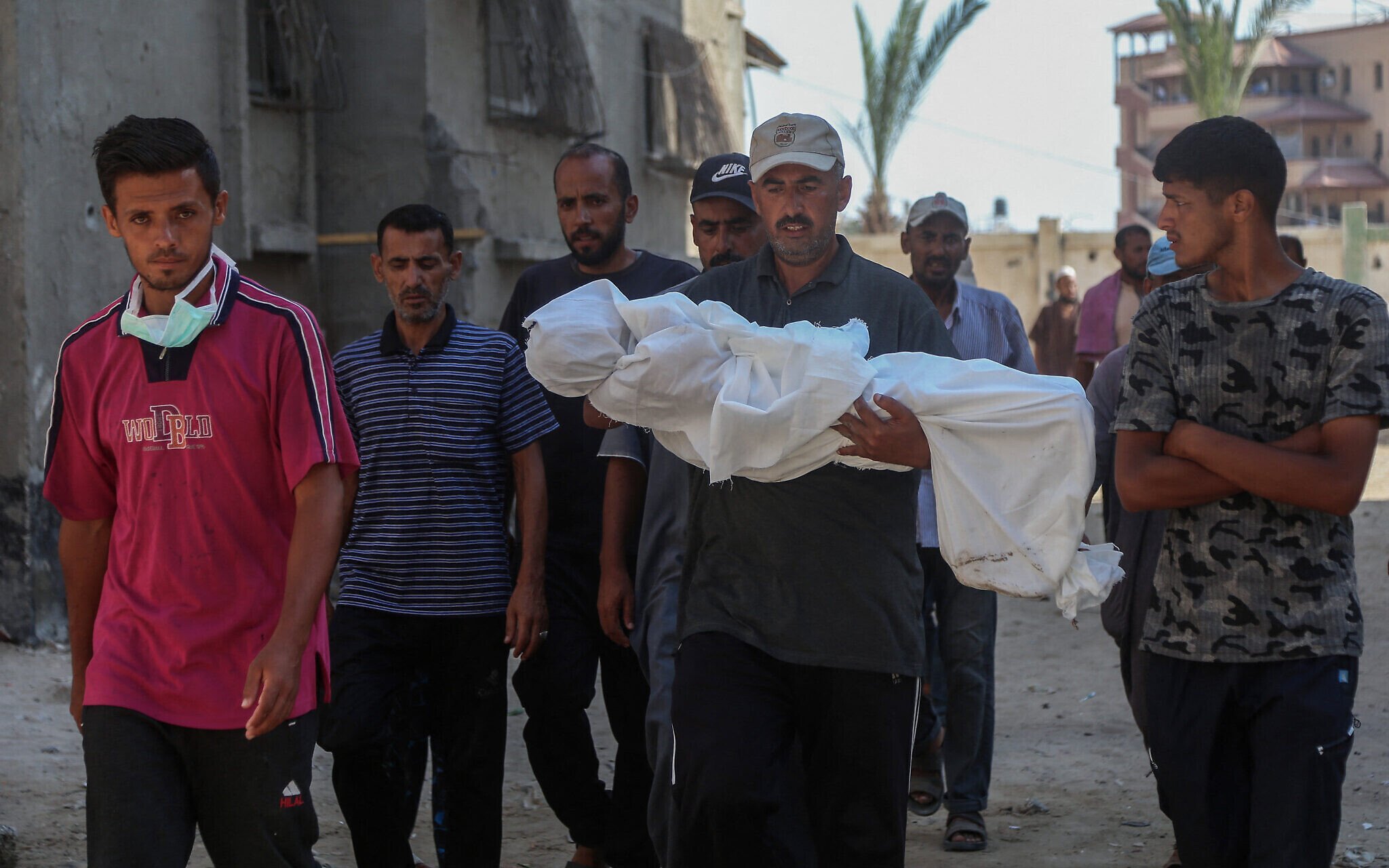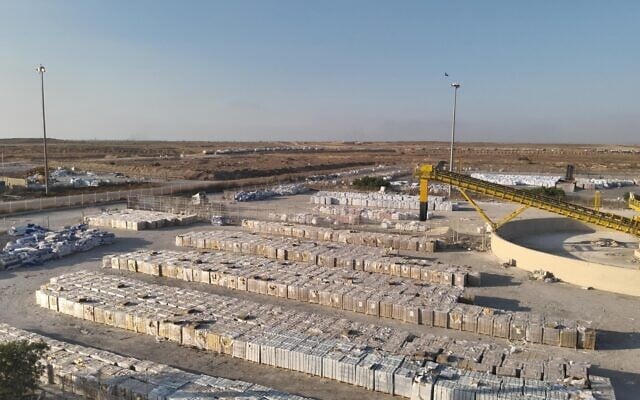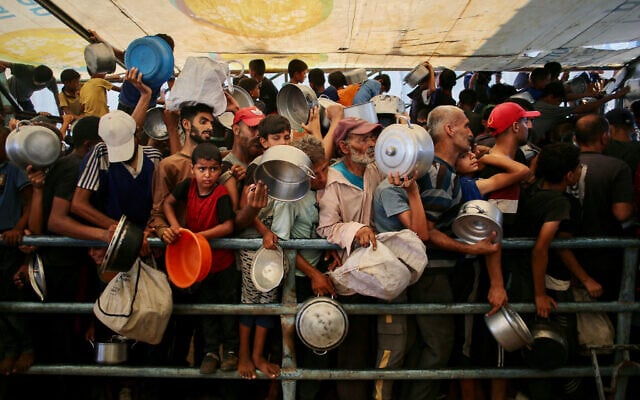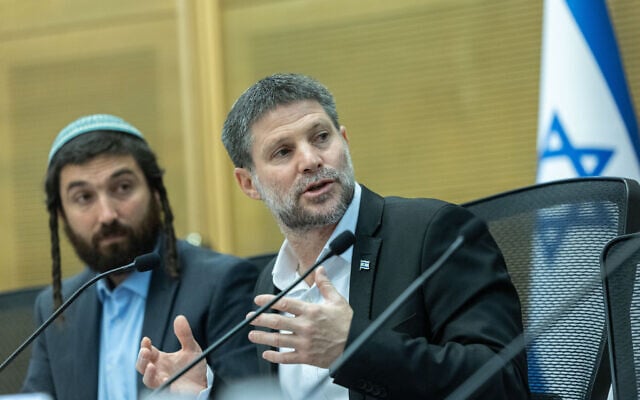



This Editor’s Note was sent out earlier Wednesday in ToI’s weekly update email to members of the Times of Israel Community. To receive these Editor’s Notes as they’re released, join the ToI Community here.
Several news agencies published photographs on Tuesday showing the dead body of a Gaza boy, named as Abdul Jawad al-Ghalban, 14. The French agency, Agence France Presse, whose photos showed his family mourning him and a medic cleaning his emaciated body in the morgue at Khan Younis’s Nasser Hospital, stated as fact that he had died of starvation. Munir Al-Barash, the director of the Hamas-run Gaza Health Ministry, said he was one of 20 Gazans to have died of starvation in the previous 48 hours — an “unprecedented” total, he stressed, given that 88 people had died of hunger since the start of the war 21 months ago.
In a briefing for Israeli reporters on Tuesday evening, an Israeli official insisted that there was no shortage of aid being made available by Israel to feed Gazans, and also that Israel had “not identified starvation at this current point in time.” The 950 trucks’ worth of aid supplies currently waiting on the Gaza side of the border crossings was itself sufficient to supply the Strip’s food needs for two and a half weeks, the official said. Nonetheless, the official also acknowledged, this aid was not actually being collected and distributed, action was required “to stabilize the humanitarian situation,” and it could be that there were difficulties with regard to accessibility to food in some parts of Gaza.
Cutting through the verbiage, the bottom line would appear to be that Israel, via its Coordinator of Government Activities in the Territories (COGAT), is making more than adequate aid available to Gazans, that the UN and other agencies are proving unable to deliver enough of it, that all the ostensibly well-intentioned actors are blaming each other for the failure, that Hamas and other armed Gazans threaten aid agencies and commandeer a substantial proportion of aid, and that while death tolls are likely inflated and manipulated, some Gazans are indeed dying for lack of food.
The Israel Defense Forces today says it controls some 75 percent of the Gaza Strip — meaning that, by its own declaration, Israel is responsible for most of Gaza, even as it continues its 21-month-plus effort to destroy the much-reduced but still deadly Hamas in the wake of the terror group’s monstrous October 7, 2023, slaughter in southern Israel. Moreover, for some 11 weeks this spring, Israel halted aid supplies to Gaza in an effort to force Hamas to agree to release hostages on Israeli terms. It then supported and apparently partly funds a new aid distribution mechanism, the Gaza Humanitarian Foundation, which daily highlights the millions of meals it says it distributes via hubs in southern and central Gaza, but where, almost daily, numerous Gazans are killed trying to obtain the precious packages.
In all, according to unverifiable UN figures, more than 1,000 Gazans have been killed trying to get hold of aid, at GHF and other sites, in the two months since the GHF began working. The IDF acknowledges that troops have opened fire in many instances, claims that the death tolls are falsely inflated without offering numbers of its own, and insists it is “learning the lessons” of its failures.
Moreover, too, Prime Minister Benjamin Netanyahu and Defense Minister Israel Katz are enthusiastic advocates of US President Donald Trump’s impractical and immoral February idea of relocating all Gazans to unknown foreign destinations. And Finance Minister Bezalel Smotrich, who is also a minister in the Defense Ministry and leader of a party without which Netanyahu’s coalition would fall apart, on Tuesday reiterated his insistence that Gaza will be annexed by Israel and will become “an inseparable part” of the state.
All of which adds up to Israel, by its own deeds and words, representing itself to its allies and critics alike as the address for all things Gazan — notably as regards the well-being or otherwise of Gaza’s civilian populace.
Tactically, the IDF has refused to itself go into the aid distribution business — having reportedly rejected the idea several times when it was raised by Netanyahu and other ministers in the course of the war. But it has found itself responsible for securing access to GHF sites and for overseeing other aid distribution mechanisms. Yet it is not trained or equipped to do so. Reservists being called into Gaza and deployed near aid distribution hubs are given no substantial training about how to handle the routine situation in which tens of thousands of Gazans converge on an aid facility, with potential Hamas gunmen in their ranks, arriving at uncoordinated times of the day, straying from intended access routes, and coming into close proximity with the IDF’s positions. Nor are they equipped with remotely adequate nonlethal crowd control means.
Israel simply cannot have its soldiers, believing themselves in genuine danger and lacking nonlethal means of protection, killing numerous Gaza civilians almost daily. It undermines the war effort. It is immoral and indefensible. Yet that is what is continuing to happen.
Strategically, the Israeli government chose not to extend the January hostage-ceasefire deal beyond March, because it was not prepared to commit to ending the war. Smotrich and his fellow far-right would-be Gaza-occupying cabinet minister Itamar Ben Gvir made clear then, as now, that they will tolerate no such conclusion. And Netanyahu has argued that the international community would not allow Israel to restart its campaign against Hamas if, or rather when, Hamas breaches any ostensibly permanent ceasefire.
By extension, Israel has proved unwilling and/or unable to foster any kind of alternative to Hamas for the governance of Gaza — not via local clans, not via the Palestinian Authority, and not via any kind of regional or US-directed mechanism.
Thus the development that would most trouble Hamas — the prospect of another entity or entities displacing it in ruling a postwar Gaza — has not been advanced.
Israel’s March-May freeze on aid did not force Hamas’s hand, since the terror group had commandeered considerable supplies ahead of time. And the subsequent Israeli effort to enable aid distribution but try to keep it out of Hamas’s hands has not worked either: Hamas can take supplies almost at will, Gaza’s noncombatants are suffering what that Israeli official warily described on Tuesday as an unstable humanitarian situation, large numbers are being killed in chaotic circumstances as they seek basic supplies, some at least are evidently dying of malnutrition. And Israel, as a function of Hamas’s cynicism and its own strategic and tactical decisions and failures, has made itself the responsible address when footage of gunfire close to Gaza aid hubs and photographs of the likes of the emaciated Abdul Jawad al-Ghalban flash around the world.
A war that began because of the absolute imperative to destroy Hamas’s military machine and get back the hostages has metastasized into an Israeli military takeover of most of Gaza, overseen by a government dependent on the support of would-be permanent occupiers of Gaza, with some 45 soldiers killed since the last ceasefire collapsed, and hundreds of Gazans dying in search of food.
The Gaza terror state built by Hamas in its ongoing declared goal of destroying Israel is largely in ruins, largely uninhabitable, and the Gazans that Hamas most deliberately placed in harm’s way are indeed suffering terrible harm — but with Israel, not Hamas, now having chosen to make itself responsible. Israel is rapidly alienating most of its closest allies while, internally fragmented, the vast majority of the public is desperate to end the war in exchange for the release of all the hostages.




